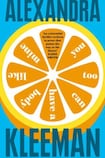
“B and I were both petite, pale, and prone to sunburn. We had dark hair, pointy chins, and skinny wrists; we wore size six shoes. If you reduced each of us to a list of adjectives, we’d come out nearly equivalent.” Nightmarish mirror images run throughout Alexandra Kleeman’s sharp and cerebral debut, a novel about consumption and hunger in a world where appearance is paramount.
Pop culture, the beauty myth and the global epidemic of clean minds and clean bodies are tackled by Kleeman in her postmodern dystopia that bears grotesque similarity to modern life. The hysterical realism genre coined in 2000 by New Yorker critic James Wood in the wake of Zadie Smith's debut, White Teeth, also fits Kleeman's absurdist America, a place where the physical body is sacrificed for image.
You Too Can Have a Body Like Mine unfolds its concerns in an inventive and sardonic manner that recalls a number of other debuts. In the sequestered voice of the narrator, A – a twentysomething woman who lives with her troubled flatmate, B, and frets about her relationship with her chronically rational boyfriend, C – are echoes of Miranda July's The First Bad Man. Modern classic debuts such as Margaret Atwood's The Edible Woman, Thomas Pynchon's V and Sylvia Plath's The Bell Jar also come to mind.
The bizarre plotting seeks to highlight the very real social problem of women starving themselves in a bid to imitate an ideal image fed to them through the media and advertising. A’s confinement in her apartment with the increasingly needy B suffocates the reader from the outset, asking us to consider the various types of disembodiment A is willing to endure.
Chopped and swallowed
With overtones of Single White Female, cosmetics are used to make the women identical. Hair is chopped off and swallowed. And the Kandy Kakes commercials that flood the apartment at all hours of the day are eerily resonant. "We know who you really are," the slogan blares from the screen. For A, struggling to retain her own identity, it seems a welcome respite.
These ads are the beginning of an outlandish plot that turns suburban America into a scarily believable dystopia. Wally's, the giant supermarket, is your average Kafkaesque Tesco, with Stasi-like assistants and aisles of fake produce. A reality TV show uses the promise of fame and money to create Identikit females and destroy relationships. Disappearing dads kidnap themselves and assume duplicate lives with better families.
As A roams the barren landscape, trying to escape from B and contact C, she happens upon the Church of the Conjoined Eaters through pamphlets at Wally’s: “Do you ever feel lost, desperate, out of control in terms of your thoughts, or as though your feelings have feelings of their own?” Promising a way back from “self-exile”, the cultish church is a fan of “eating Bright” and living in the present moment, satirising a multitude without ever mentioning mindfulness or Nutribullets.
For all the book’s lurid qualities, Kleeman’s dry humour also comes through, particularly on her relationship woes: “With C, I could sit there and cycle through hurt, anger, sadness, ambivalence, acceptance, all without disturbing the comfortable rapport between us. As a result, he called me easygoing.” Later she wonders why he hasn’t called her back: “I was barely able to get him to return a text message, even the dirty ones.”
As she ponders whether consumption is a form of infiltration, A is never far from thinking about hunger. B is like the darkest version of herself. She subsists on frozen Popsicles, “stuff that was more like a colour than a food”, and visits the supermarket only as a food tourist – “her term for the activity of coming to Wally’s with a digital camera and rigorously photographing all of the doughnuts”.
Seeing myself
Kleeman’s punch comes with her narrator’s realisation that she is fooling herself by thinking that B is worse off: “She seemed so fragile when I had first opened the door, startlingly small in an overlarge dress and bare face. But she wasn’t really any smaller than me – I just couldn’t see myself from the outside”.
The ludicrous subplots sometimes flag, as with the tiresome Kandy Kakes ad analogies. Overall, though, Kleeman sustains her absurdist world with writing both elegant and disturbing (“I felt like a person learning that a surgeon had left a pair of scissors inside her during an operation”). The author is great on the beauty industry, including a wonderful sequence where A literally paints B to life, noting “that anonymous female scent that we rub onto ourselves to blend into a wet, aggregate femininity”.
Kleeman, a New York-based writer of fiction and nonfiction, has been published in the Paris Review, Zoetrope: All-Story, Conjunctions, Guernica, Gulf Coast and the Guardian, and she won the 2016 Bard Fiction Prize. She is undoubtedly a voice to watch for the future: "There was an uncontrollable amount of me within myself, and I didn't know how to stop it."
Sarah Gilmartin is an arts journalist.












